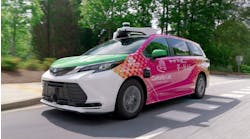CA: DMV shuts down Cruise robotaxis in San Francisco, saying company misled on safety
By Ethan Baron
Source Bay Area News Group (TNS)
The California Department of Motor Vehicles on Tuesday shut down the problem-plagued Cruise autonomous taxis in San Francisco, saying they were an “unreasonable risk to the public” and that the company misrepresented how safe they are.
The agency said Cruise, to get its permits back for testing and deploying driverless taxis with no human backup, would have to provide it with information about “how it has addressed the deficiencies that led to the suspensions.”
The suspension has no set duration, the DMV said.
In August, the state Public Utilities Commission gave GM’s Cruise a green light to take paid fares in hundreds of robotaxis with no human backup in San Francisco, despite incessant reports of the cars obstructing emergency vehicles and bottlenecking traffic. San Francisco Board of Supervisors president Aaron Peskin at the time called allowing the autonomous technology on public roads “a recipe for death” and said the vehicles were “not ready for prime time.”
On Tuesday, Peskin applauded the DMV’s move to suspend Cruise’s permits as having come “better late than never.” California, Peskin said, “should never have allowed their unlimited deployment in the first place.”
San Francisco has become a leading proving ground for autonomous vehicle technology, with Cruise and Google spinoff Waymo testing out their technology on public roads. But Cruise’s robotaxis have come under fire from city officials over their propensity to snarl traffic and obstruct emergency vehicles, and the DMV in August pushed the company to reduce its fleet.
Autonomous taxis have not been deployed elsewhere in the Bay Area, but San Jose and Oakland officials have said they are closely watching the technology’s roll-out, with Oakland officials saying last year in a letter to the Public Utilities Commission that they know their city “may be next” for robotaxi expansion
Cruise spokeswoman Navideh Forghani said Tuesday that the company develops and deploys autonomous vehicles “in an effort to save lives.”
Forghani referred to an accident early this month involving a pedestrian hit by a car then trapped beneath a Cruise robotaxi, and described it as “the incident being reviewed by the DMV.” The agency said it suspended the company’s permits for safety reasons “based upon the performance of the vehicles.”
The DMV also said Cruise had “misrepresented … information related to safety of the autonomous technology of its vehicles.”
The agency has told Cruise the steps it must take to get its permits back. Cruise can continue to operate the vehicles with a backup human driver, the DMV said.
When the Public Utilities Commission announced the expansion in August, commissioner John Reynolds — a lawyer for Cruise until joining the agency last year — said he and his colleagues did “not yet have the data to judge (the technology) against the standard human drivers are setting.” But he said the vehicles could increase road safety, and companies and first responders needed to collaborate to address problems.
Just over a week after the commission gave the go-ahead to Cruise and Google spinoff Waymo to operate in San Francisco with no backup, the DMV cited “concerning incidents” and demanded Cruise “immediately reduce its active fleet of operating vehicles.” Cruise agreed to reduce its operations to no more than 50 driverless vehicles in operation during the day, and 150 at night.
That action by the DMV followed closely upon two Cruise crashes in San Francisco, one of them involving a robotaxi passenger suffering injuries after the vehicle was hit by a fire truck responding to an emergency scene.
In an August report, San Francisco Fire Chief Jeanine Nicholson, city police and transit officials said autonomous taxis, a majority from Cruise, had made nearly 600 documented unexpected stops since June 2022, “likely a fraction of actual incidents.” Peskin said at the time the vehicles had interfered with emergency responders more than 60 times.
Cruise claims its robotaxis, when measured against humans driving ride-hail vehicles in comparable environments, have been involved in 65% fewer collisions.
©2023 MediaNews Group, Inc. Visit at mercurynews.com. Distributed by Tribune Content Agency, LLC.
